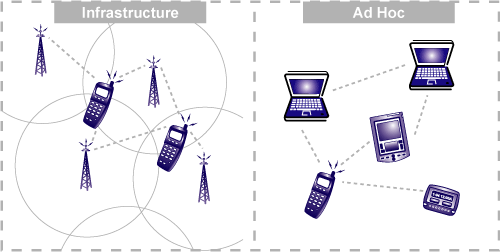Connectivity of the Internet of Things
Infrastructure and Ad-hoc Networks
Since we are going to talk about wireless networks today, we need to discuss the two basic modes (also referred to as topologies) in which wireless networks operate.
-> Infrastructure and Ad-hoc Networks <-
Infrastructure mode is when the wireless network requires a physical structure to support it. This essentially means there should be a medium handling the network functions, creating an infrastructure around which the network sustains.
It performs these typical functions:
- Providing access to other networks
- Forwarding
- Medium access control
In infrastructure-based wireless networks, the communication takes place between the wireless nodes (i.e., endpoints in the network such as your computer, your phone, etc.) and the access points (i.e., the router) only.
There can be more than one access point on the same network handling different wireless nodes.
A typical example of an infrastructure network would be cellular phone networks. They have to have a set infrastructure (i.e., network towers) to function.
When to use an infrastructure network:
- If you can easily add more access points to boost the range
- If you want to set up a more permanent network
- If you will need to bridge to other types of networks (e.g., you can connect to a wired network if required)
Ad-hoc wireless networks, on the other hand, do not require a set infrastructure to work. In ad-hoc networks, each node can communicate with other nodes, so no access point that provides access control is required.
Whereas the routing in infrastructure networks is taken care of by the access point, in ad-hoc networks the nodes in the network take care of routing.
Routing is to find the best possible path between the source and destination nodes to transfer data.
All the individual nodes in an ad-hoc network maintain a routing table, which contains the information about the other nodes. As the nature of the ad-hoc network is dynamic, this results in ever-changing router tables. One important thing to note is that an ad-hoc network is asymmetric by nature, meaning the path of data upload and download between two nodes in the network may be different.
A typical example of an ad-hoc network is connecting two or more laptops (or other supported devices) to each other directly without any central access point, either wirelessly or using a cable.
When to use an ad-hoc network:
- If you want to quickly set up a peer-to-peer (P2P) network between two devices
- When creating a quick temporary network
- If there is no network infrastructure set up in the area (ad-hoc is the only network mode that can be used in areas like this)
